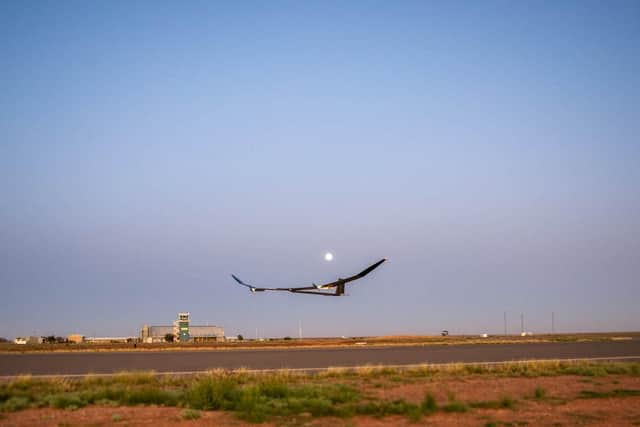BAE Systems' first test flight of aircraft that can stay in the sky for a year
and live on Freeview channel 276
The pilotless aircraft, Phasa-35, is designed as a high altitude observation platform, an alternative to satellites which the company believes will be a game changer in the air and space market.
The 35 metre wingspan carbon fibre aircraft has been designed, built and now flown in less than two years as part of a collaboration between BAE Systems and Prismatic Ltd which the Company bought last year.
Advertisement
Hide AdAdvertisement
Hide AdDesigned to operate unmanned in the stratosphere, high above the weather and conventional air traffic, the aircraft can be used to monitor such things as shipping, forest fires, borders, or be used in disaster control areas, giving an overview of what is going on down on the ground.


In such areas it could also act as a kind of 5G relay, providing emergency services on the ground with better mobile coverage in remote disaster zones.
Although the aircraft flies at speeds slower than Usain Bolt can run, with its solar panel wings and hi-tech battery, it can stay airborne for months on end and would be more mobile and much cheaper than a satellite.
The flights are the culmination of efforts from a collaborative team of British experts from Prismatic in Hampshire - where two full-sized concept aircraft were built last year - working alongside BAE Systems engineers in Warton, where the aircraft underwent further integration testing prior to flight trials.
Advertisement
Hide AdAdvertisement
Hide AdThe company said the trials marked the first fully integrated flight test of the Phasa-35 system, delivering rapid proof of capability from design to flight in just 20 months.
Ian Muldowney, Engineering Director for BAE Systems, said: “This is an outstanding early result that demonstrates the pace that can be achieved when we bring the best of British capability together. To go from design to flight in less than two years shows that we can rise to the challenge the UK Government has set industry to deliver a Future Combat Air System within the next decade.”
Sponsored by the UK’s Defence Science and Technology Laboratory (DSTL) and Australian Defence Science and Technology Group (DSTG), the successful flight trials took place at the Royal Australian Air Force (RAAF) Woomera Test Range in South Australia.
Further flight trials are scheduled for later this year, with the possibility that the aircraft could enter initial operations with customers within 12 months of the flight trials programme completion.